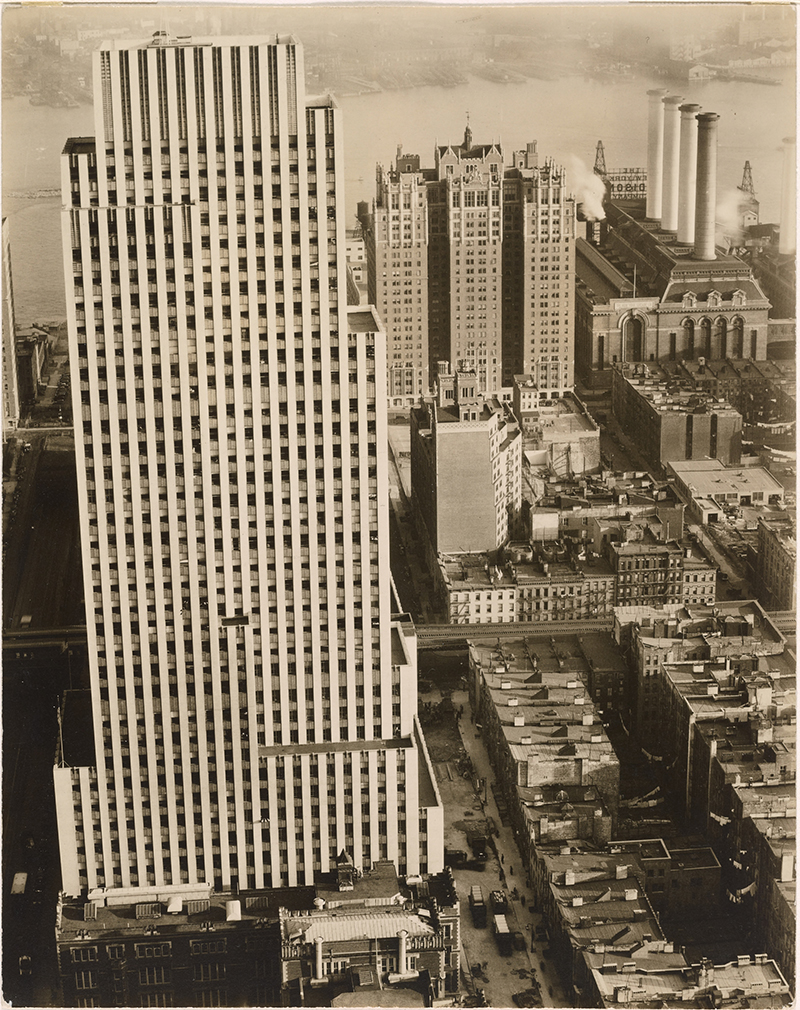Berenice Abbott’s "Daily News Building, 42nd Street between 2nd and 3rd Avenue" (1935)
By Bowdoin College Museum of Art
Daily News Building, 42nd Street between 2nd and 3rd Avenue, 1935, gelatin silver print by Berenice Abbott, American, 1898–1991. Bowdoin College Museum of Art.
Earlier this spring, the Museum of Art opened Creeping Pavement: Depictions of an Urbanizing America, an exhibition in the Museum’s Becker Gallery organized by members of the 2019–20 Student Museum Collective, including Sylvia Bosco ’21, Joseph Hilleary ’20, Cassie Jackson ’22, Sabrina Lin ’21, and Ben Wu ’18. Originally scheduled to open in the spring of 2020, Creeping Pavement will now remain on view through September 26.
One of the many outstanding photographs in the exhibition is Berenice Abbott’s Daily News Building, 42nd Street between 2nd and 3rd Avenue, a gelatin silver print created in 1935. About this image, the student curators write: “This photograph is part of Berenice Abbott’s ‘Changing New York’ series, created through support of the Works Project Administration during the Great Depression. From this lofty viewpoint, Abbott captures the strikingly modern skyline of New York, including the Daily News Building, which was completed in 1930. While the photographer Lewis Hine foregrounds the people building these structures, Abbott instead focuses on capturing the new perspectives that such buildings now afford. The grid lines of the city and the tilted angle of the photograph emphasize the height and sprawl of New York—it is huge, and it is growing. In the background, smoke billows up from factories, highlighting the ongoing ‘progress’ of the city.”
After nearly four decades working in New York City, Abbott moved to Maine—first seasonally, and then permanently beginning in 1967. Settling in Blanchard and later in Monson in central Maine, she quite deliberately left behind urban society and found rural Maine a compelling subject for her evolving photographic practice. Her landmark book of photographs A Portrait of Maine (1968) is one product of her work in the state.
In introducing Creeping Pavement, the student curators wrote: “In America, cities are places of contrast and connection. They bring people together, yet often highlight the tensions that divide us. Cities are home to both the wealthy and the least privileged. Inhabitants hail from near and far, yet all see themselves as a part of the city’s identity. Thus, the art created when these urban centers developed offers a unique perspective on American life in the nineteenth and twentieth century. Tracing the evolution of the American city as it grew into its own distinct environment, this exhibition explores the many ways artists reacted to the rapid urbanization of American life … If recent events have demonstrated the vulnerability and even the fragility of cities and their inhabitants, these works of art from the past provide a powerful reminder of their resilience.”
Abbott understood well the dreams and challenges of urban America. Photographs such as Daily News Building, 42nd Street between 2nd and 3rd Avenue—created when the artist was thirty-seven years old—reflect her exuberance for modern New York. Over time, however, she began to tire of the city and increasingly understood that material “progress” did not always lead to individual happiness nor to civic unity. When the Museum re-opens this summer, we invite you to see Creeping Pavement and to dwell on the larger questions that this photograph and other art works in the exhibition introduce.
Frank Goodyear
Co-Director, Bowdoin College Museum of Art